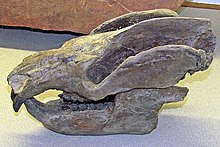
Back Kayentatherium Spanish Kayentatherium Italian Кајентатериум Macedonian Kayentatherium Dutch Kayentatherium Ukrainian 卡岩塔獸屬 Chinese
| Kayentatherium Temporal range:
| |
|---|---|

| |
| Skull of K. wellesi | |
| Scientific classification | |
| Domain: | Eukaryota |
| Kingdom: | Animalia |
| Phylum: | Chordata |
| Clade: | Synapsida |
| Clade: | Therapsida |
| Clade: | Cynodontia |
| Family: | †Tritylodontidae |
| Genus: | †Kayentatherium Kermack, 1982 |
| Type species | |
| †Kayentatherium wellesi Kermack, 1982
| |
| Synonyms | |
| |
Kayentatherium is an extinct genus of tritylodontid cynodonts that lived during the Early Jurassic. It is one of two tritylodonts from the Kayenta Formation of northern Arizona, United States.
Kayentatherium means "Kayenta Beast", and is named for the geological formation in which it was found, the Kayenta Formation. Kayentatherium is known from several specimens.[1][2] The specific name honors paleontologist Samuel Welles, who worked with the University of California Museum of Paleontology in much of the pioneering work on the paleontology of the Kayenta Formation.[1]
- ^ a b Kermack, D. 1982. A new tritylodont from the Kayenta Formation of Arizona. Zoological Journal of the Linnean Society, 76. 1-17.
- ^ Sues, Hans-Dieter & F. A. Jenkins. 2006. The Postcranial Skeleton of Kayentatherium Wellesi from the Lower Jurassic Kayenta Formation of Arizona and the Phylogenetic Significance of Postcranial Features in Tritylodontid Cynodonts in: Carrano, Matthew T., Gaudin, T. J., Blob, R. W. and Wible, J. R., Amniote Paleobiology: Perspectives on the Evolution of Mammals, Birds, and Reptiles: The University of Chicago Press. pp. 114-152.